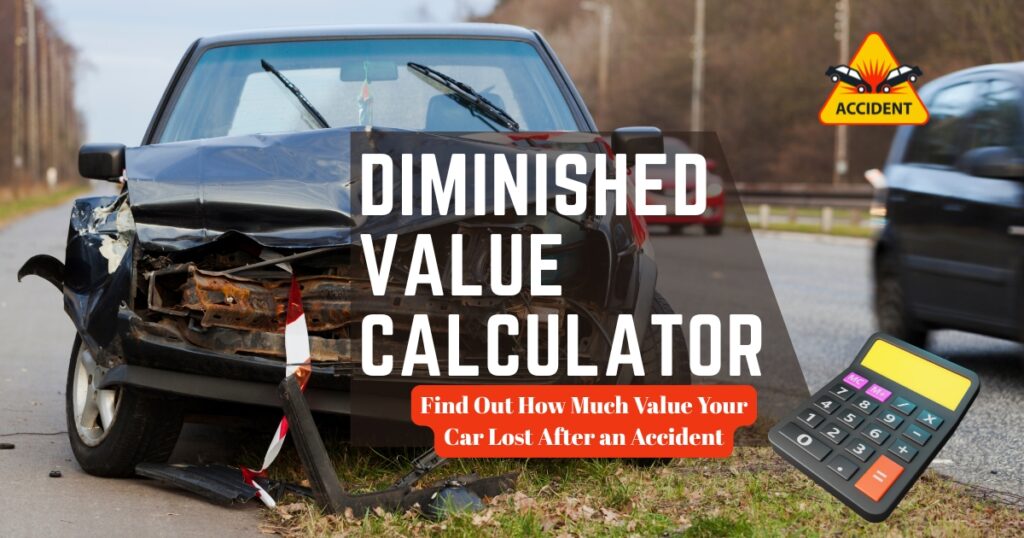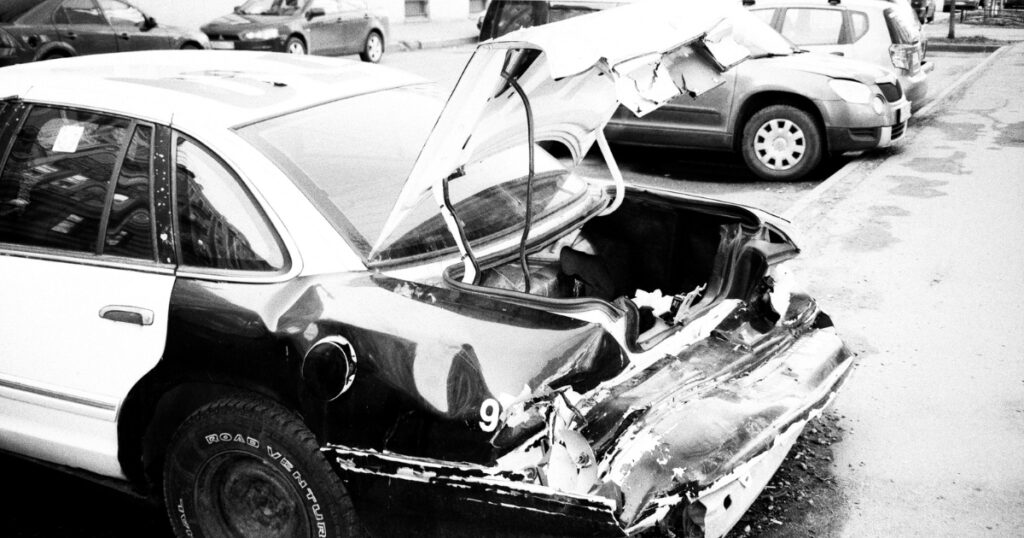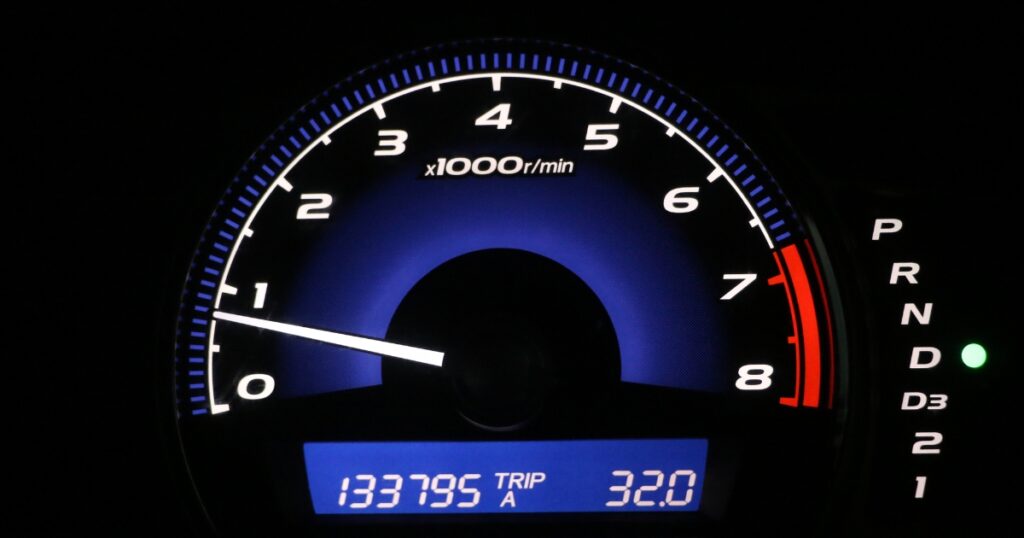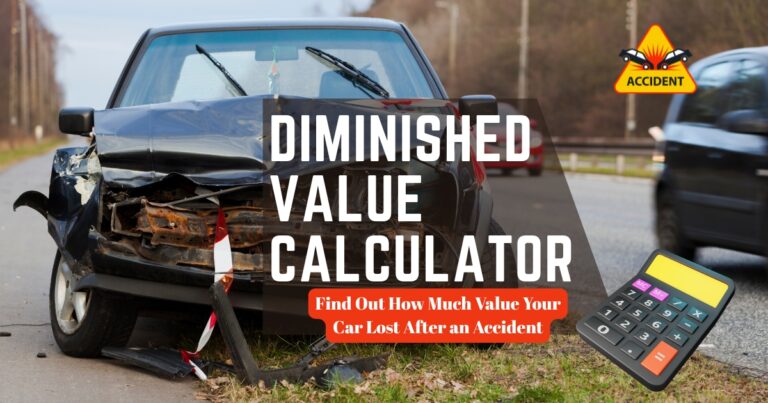
Diminished Value Calculator
Diminished Value Calculator
Quickly estimate how much value your car lost after an accident using the 17c formula.
Being in a car accident is stressful enough without having to stress over its impact on your car’s resale value. Even if your car is in perfect condition, Having a Zero accident history, the bad news is When that history report shows that car has been in an accident, the value of that car decreases massively. This undisclosed liability to a car’s value is called diminished value and impacts thousands of drivers every year.
The good news? You may be able to calculate this loss with a reduced value calculator and you might be eligible to receive it back either in arbitration, or in small claims against the shop. In this in-depth guide, we’ll cover everything you need to know about what diminished value is, how to calculate it, how and when you should file a claim for it, and how to use our free, easy-to-use diminished value calculator.
What Is Diminished Value?
The diminished value is the amount a vehicle has depreciated in its market value as a result of an accident and repair. Even with perfection in repairs, clients very wary of a vehicle with a damage history — no matter how thoroughly repaired by an expert shop — offering less for resale or trade-in.
There are three primary types of diminished value:
| Type of Diminished Value | Description |
|---|---|
| Inherent Diminished Value | The automatic decreased value post accident, even though the car is perfect. This is claimed, in terms, most frequently. |
| Repair-Related Diminished Value | Value lost from bad repair work, different paint, or others problems. |
| Immediate Diminished Value | The diminished value after an accident prior to repairs. Rarely used for claims. |
Why It Matters
If someone else is responsible for your accident, their insurance company could owe you not only for the cost of repairs, but also for the car’s diminished value. A lot of folks don’t understand diminished value claims, or how to prove them.
This is the point at which a diminished value calculator is so handy. You get an estimate based on data that you can use to bolster your argument.
Who Can Make A Diminished Value Claim?

You could be eligible for a claim if:
- You were not at fault for the accident
- You are not leasing the car you are driving
- You are in a state that does allow diminished value claims (all but Michigan)
You may not qualify if:
- You were responsible for the accident
- You already had a high-mileage car or a troubled history.
- Your car is leased and the leasing company manages value claims
Introducing the Diminished Value Calculator (17c Formula-Based)

Our diminished value calculator is based on the 17c formula, a formula in use since the 90s when the Georgia Supreme Court agreed to use a set formula and be done with negotiations. This formula has its origins in a 2001 Georgia court case, Mabry v. State Farm, and it’s employed by both insurers and appraisers.
In just 3 inputs: market value, mileage, and severity of damage, you now have the ability to create an instant, credible diminished value claim.
How the 17c Formula Works
Let’s break down the 17c formula into a clear, step-by-step calculation.
Step 1: Identify the cap to the 10%

Multiply your car’s pre-accident market value by 10%. This is the highest your claim can start at.
| Market Value | 10% Cap |
|---|---|
| $25,000 | $2,500 |
| $30,000 | $3,000 |
| $40,000 | $4,000 |
Step 2: Apply Damage Severity Multiplier

This proportionally scales the value according to the severity of the damage.
| Damage Level | Multiplier | Description |
|---|---|---|
| Severe structural damage | 1.00 | Frame damage, deployed airbags |
| Major damage | 0.75 | Multiple panels affected |
| Moderate damage | 0.50 | Some structural repair needed |
| Minor damage | 0.25 | Cosmetic or surface issues |
| No structural damage | 0.00 | Replaced parts only, no frame damage |
Step 3: Apply Mileage Multiplier

Next, reduce the number based on your car’s mileage at the time of the accident.
| Mileage Range | Multiplier |
|---|---|
| 0 - 19,999 miles | 1.00 |
| 20,000 - 39,999 miles | 0.80 |
| 40,000 - 59,999 miles | 0.60 |
| 60,000 - 79,999 miles | 0.40 |
| 80,000 - 99,999 miles | 0.20 |
| 100,000+ miles | 0.00 |
Example Calculation Using Our Diminished Value Calculator
Let’s walk through a sample calculation:
- Market Value: $30,000
- Damage Level: Moderate (0.50)
- Mileage: 35,000 miles (0.80)
Formula:
- 10% of $30,000 = $3,000
- $3,000 x 0.50 damage = $1,500
- $1,500 x 0.80 (depreciation) = $1,200 DV
Now, subtract this value from the original one:
- $30,000 - $1,200 = $28,800 Current Estimated Car Value
How to Use the Diminished Value Calculator Tool
We’ve developed a sleek, responsive tool that allows you to run this calculation in seconds.
🖱️ Step-by-Step Instructions:
- Enter Pre-Accident Market Value (approx from Kelley Blue Book or Edmunds)
- Enter Accident Mileage
- Choose Damage Severity from the drop down.Sequence the rows.
- Click “Calculate”
- Instantly see:
- Estimated Diminished Value
- Current Estimated Car Value
Tip: Screenshot or print the result card to send along with your insurance claim.
Filing a Diminished Value Claim
Here’s what you should do after using the diminished value calculator:
Checklist
| Task | Notes |
|---|---|
| ✅ Get pre-accident value | Use KBB or NADA |
| ✅ Use our calculator | Save the result |
| ✅ Contact at-fault driver's insurer | Ask for diminished value claim form |
| ✅ Submit evidence | Include photos, repair records, and your calculator result |
| ✅ Consider appraisal | For high-value cars, use a licensed vehicle appraiser |
Real-World Example
Suppose you own a 2024 Hyundai Tucson valued at $28,000 with just 2,780 miles on it. You have an accident in which the car gets minor damage in a few panels.
- 10% cap = $2,800
- Damage multiplier = 0.25
- Mileage multiplier = 1.00
Estimated Diminished Value = $2,800 × 0.25 × 1.00 = $700
Why Use Our Diminished Value Calculator?
Our diminished value calculator is:
- Real, historical legal precedent (17c formula)
- User friendly and mobile responsive
- Contains useful, educational results summaries
- 100% free and anonymous
Stop guessing. Start claiming. If someone damaged your car, you ought to receive full and fair compensation for all kinds of losses — including your car’s depreciated fair market value.
Frequently Asked Questions On Diminished Value Calculator
What is a Diminished Value Calculator and How Does it Work?
The purpose of a diminished value calculator is to provide an approximation of the loss of value your car has suffered following an accident. Even once brought back to professional repair, a car that has a documented accident history auctions, sells on the dealer’s lot and trades hands for considerably less than an otherwise identical car with a clean history. This loss of resale or trade in value is called diminished value.
The 17c formula, which is utilized by insurance companies nationwide, is the most commonly accepted means of calculating this. The steps involved are:
Assess what the vehicle was worth prior to the accident.
Cap that market value at 10 percent.
Multiply by a damage severity factor (amplifier; 0.00 to 1.00 for less to totally damage).
Multiply by a mileage factor (between 1.00 and 0.00, depending on the odometer reading).
The end result is a fair approximation of how much value the car has lost as a result of the accident. This figure can assist you when you're working on a diminished value claim with the negligent driver's insurance company.
Why Should I Use a Diminished Value Calculator After an Accident?
Diminished value calculator is what car owners need in order to understand how much value their vehicle has lost because of an accident. Making it even were your car completely returned to its original shape, the car accident history will weigh heavily on its resale or trade back value.
Here are some cases for which you might want to use the calculator:
It provides you a baseline from which to file a diminished value claim.
It enables you to make a better-informed decision on whether to sell or keep the vehicle.
It may be helpful in negotiating with insurance companies or car dealers.
It might inform your decision to hire a professional appraiser or a lawyer.
With such a reliable estimate from a diminished value calculator, you are in a much stronger position to get back all the thousands and thousands of dollars you’ve lost as a result of the depreciation that occurred as a result of the accident.
What Information Do I Need to Use a Diminished Value Calculator?
In order to effectively use an online diminished value calculator, you’ll need a few specific details about your car and the accident you were involved in. These include:
The pre-accident value of your car (usually determined by Kelley Blue Book, Edmunds, and/or NADA guides).
The severity of vehicle damage (minor, moderate, major, or structural).
The quality of repairs (for purposes of diminished value due to repairs).
The number of miles on the vehicle when the accident happened.
Your vehicle's year, make, and model.
The calculator then calculates an estimated diminished value amount using the 17c formula based on this data. This estimate does not have the force of law, and you will want to obtain your nickel back in order to start making your claim or determine your economic loss.
Can I File a Diminished Value Claim Using the Estimate From the Calculator?
Yes, in all states you may use the calculated diminished value from the diminished value calculator as a guideline when submitting a diminished value claim. This claim is typically filed against the at-fault driver’s insurance but in some cases (like hit-and-run accidents) you can file the claim with your own insurance, assuming you have uninsured motorist coverage.
Keep in mind:
Each state has its own set of rules and procedures for diminished value claims.
Calculator results may be supplemented with professional appraisals, as desired by some insurance companies.
In Michigan, you can't file for diminished value, you must sue to receive anything.
Does the calculator guarantee that we’ll be paid? Although it’s not a guaranteed payout the calculator gives you a good place to start negotiations. Thorough documentation of your claim, along with evidence of repairs, accident reports and photos can help you make your case.make your case.
Is the Diminished Value Calculator Accurate and Legally Accepted?
A reduced value calculator gives you an approximate figure using the now industry-recognized 17c formula which came in to being from a court ruling in Georgia in 2001. Although a calculator is not a legally binding device, the methodology of this calculator is used universally as an equitable means of determining loss in value.
But the insurer gets the last say whether they will pay out a diminished value settlement and if they do many times will use their own in house formulas to figure the amount. Insurers sometimes provide much lower settlements than the calculator’s estimate. If that happens, you can:
Go to find a certified vehicle appraiser and have them do an appraisal.
Send a demand letter that contains your figures and evidence.
Take the claim to small claims court, or use a lawyer, depending on the stakes.
In the end, a diminished value calculator is not a promise of compensation but is the critical first step to knowing what you stand to lose and to building your case for repayment.
Final Thoughts
But the costliest part of a car accident isn’t the repair tab, it may be your vehicle’s value after you’ve fixed it. And that is where the diminished value calculator comes in. It gives you a lead in numbers and proof and self-assurance, under such a claim.
Don’t settle for less. Try our tool today to see what your car is actually worth after an accident. You might be surprised by the sum of money you’re owed.



